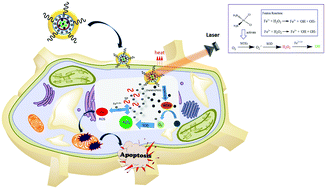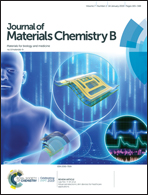Reactive oxygen species mediated theranostics using a Fenton reaction activable lipo-polymersome†
Abstract
Recently, reactive oxygen species (ROS)-induced apoptosis has been widely studied by researchers through various means. Among them, the singlet oxygen produced by the Fenton reaction is particularly effective in killing tumor cells. Although photodynamic therapy (PDT) takes advantage of the spatial-temporal control of ROS production, the design of the Fenton reaction in an ingenious way is still a question worth exploring. Herein, we have designed and prepared a succinic peroxide-filled Fenton reaction activable Pt/Fe3O4@SP-PLGA lipo-polymersome that displays ROS mediated chemodynamic therapy (CDT). The therapeutic element, ˙OH, is generated under NIR irradiation/tumor acidic pH environment through engineering the reaction between succinic peroxide (SP) and iron oxide. Instead of using single endogenous H2O2 or even encapsulation, the conjugation with SP in the Pt/Fe3O4@SP-PLGA lipo-polymersome provides a more stable, high-yielding peroxygen source. The results also showed that after the addition of cisplatin, the amount of ROS production increased significantly. The proof-of-concept design of the Fenton reaction activable Pt/Fe3O4@SP-PLGA lipo-polymersome with enhanced ROS-generation characteristics provides a general approach to afford potent ROS-mediated cancer therapy.



 Please wait while we load your content...
Please wait while we load your content...